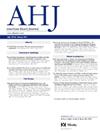Variations in antihypertensive medication treatment and blood pressure control among Veterans with HIV and existing hypertension
IF 3.7
2区 医学
Q1 CARDIAC & CARDIOVASCULAR SYSTEMS
引用次数: 0
Abstract
Background
Hypertension is a leading risk factor for cardiovascular disease among patients living with HIV (PLWH). Understanding the predictors and patterns of antihypertensive medication prescription and blood pressure (BP) control among PLWH with hypertension (HTN) is important to improve the primary prevention efforts for this high-risk population. We sought to assess important patient-level correlates (eg, race) and inter-facility variations in antihypertension medication prescriptions and BP control among Veterans living with HIV (VLWH) and HTN.
Methods
We studied VLWH with a diagnosis of HTN who received care in the Veterans Health Administration (VHA) from January 2018 to December 2019. We evaluated HTN treatment and blood pressure control across demographic variables, including race, and by medical comorbidities. Data were also compared among VHA facilities. Predictors of HTN treatment and control were assessed in 2-level hierarchical multivariate logistic regression models to estimate odds ratios (ORs). The VHA facility random-effects parameters from the hierarchical models were used to calculate the median odds ratios to characterize the variation across the different VHA facilities.
Results
A total of 17,468 VLWH with HTN (mean age 61 years, 97% male, 54% Black, 40% White) who received care within the VHA facilities in 2018-2019 were included. 73% were prescribed antihypertension medications with higher prescription rates among Black vs White patients (75% vs 71%) and higher prescription rates among patients with a history of cardiovascular disease, diabetes, and kidney disease (>80%), and those receiving antiretroviral therapy and with controlled HIV viral load (∼75%). Only 27% of VLWH with HTN had optimal BP control of systolic BP <130 mmHg and diastolic BP <80 mmHg, with a lower rate of control among Black vs White patients (24% v. 31%). In multivariate regression, Black patients had a higher likelihood of HTN medication prescription (OR 1.32, 95% CI: 1.22-1.42) but were less likely to have optimal BP control (OR 0.82; 0.76-0.88). Important positive correlates of antihypertensive prescription and optimal BP control included: number of outpatient visits in prior year, and histories of diabetes, coronary artery disease, and heart failure. There was about 10% variability in both antihypertensive prescription and BP control patterns between VHA facilities for patients with similar characteristics. There was increased inter-facility variation in antihypertensive prescription among those with a history of heart failure and those not receiving antiretroviral therapy.
Conclusion
In a retrospective analysis of large VHA data, we found that VLWH with HTN have suboptimal antihypertensive medication prescription and BP control. Black VLWH had higher HTN medication prescription rates but lower optimal BP control.
感染艾滋病毒并患有高血压的退伍军人在抗高血压药物治疗和血压控制方面的差异。
背景:高血压是艾滋病病毒感染者(PLWH)罹患心血管疾病的主要风险因素。了解患有高血压(HTN)的艾滋病病毒感染者的降压药物处方和血压(BP)控制的预测因素和模式,对于改善这一高风险人群的初级预防工作非常重要。我们试图找出患者层面的重要相关因素(如种族),并评估感染艾滋病毒的退伍军人(VLWH)和高血压患者在抗高血压药物处方和血压控制方面的机构间差异:我们研究了 2018 年 1 月至 2019 年 12 月期间在退伍军人健康管理局(VHA)接受治疗的诊断为高血压的 VLWH。我们评估了不同人口统计学变量(包括种族)和不同医疗合并症的高血压治疗和血压控制情况。我们还对退伍军人健康管理局各机构的数据进行了比较。在两级分层多变量逻辑回归模型中评估了高血压治疗和控制的预测因素,以估算出几率比(OR)。分层模型中的VHA设施随机效应参数用于计算中位几率比,以描述不同VHA设施之间的差异:共纳入17468名患有高血压的VLWH(平均年龄61岁,97%为男性,54%为黑人,40%为白人),他们于2018-2019年在VHA设施内接受治疗。73%的患者处方了抗高血压药物,其中黑人与白人患者的处方率更高(75% vs. 71%),有心血管疾病、糖尿病和肾脏疾病病史的患者处方率更高(>80%),接受抗逆转录病毒治疗且HIV病毒载量得到控制的患者处方率更高(∼75%)。在患有高血压的 VLWH 患者中,只有 27% 的人收缩压得到了最佳控制:在对 VHA 大量数据的回顾性分析中,我们发现患有高血压的 VLWH 的降压药物处方和血压控制均未达到最佳水平。黑人超低体重儿的高血压药物处方率较高,但最佳血压控制率较低。
本文章由计算机程序翻译,如有差异,请以英文原文为准。
求助全文
约1分钟内获得全文
求助全文
来源期刊

American heart journal
医学-心血管系统
CiteScore
8.20
自引率
2.10%
发文量
214
审稿时长
38 days
期刊介绍:
The American Heart Journal will consider for publication suitable articles on topics pertaining to the broad discipline of cardiovascular disease. Our goal is to provide the reader primary investigation, scholarly review, and opinion concerning the practice of cardiovascular medicine. We especially encourage submission of 3 types of reports that are not frequently seen in cardiovascular journals: negative clinical studies, reports on study designs, and studies involving the organization of medical care. The Journal does not accept individual case reports or original articles involving bench laboratory or animal research.
 求助内容:
求助内容: 应助结果提醒方式:
应助结果提醒方式:


